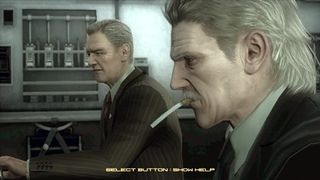With so much we can’t share - like the string of set-pieces in [deleted], which are even better than the ending of MGS3 Snake Eater - let’s talk about what MGS4 isn’t: an unrecognisable departure. Strip away the gloss, the mythology of the trailers, the gravity of Snake’s predicament, and the core experience is classic Metal Gear - a fusion of MGS3’s advanced mechanics and MGS2’s cutscene-and-set-piece-heavy eclectic feel. It’s as fiddly, deep and rewarding as ever.

In fact, the polarities are stretched: it’s less fiddly and deeper - the series’ most-refined mechanics yet: with a more direct, gung-ho, feel for newcomers; and incredible emergent AI, stealth possibilities and multi-route playgrounds for veterans. Your first play through will only yield a fraction of the game’s true potential, and it’s possible to complete it while completely ignoring many of the game’s incredible features. For example, we only used the drum can roll ability once. And barely touched the array of Stun/Sleeping Gas/Smoke grenades. It’s a game you play by your own rules, and as such, it’s initially bewildering.
Structurally, we’re sworn to secrecy, but in Kojima’s words, it’s closer to MGS2 in feel than MGS3 - he described MGS4 and MGS2 as “on a level, while MGS is more like MGS3” - i.e. it’s cut-scene heavy and piecemeal, while MGS3 was a more focused, personal journey. MGS3 described how a noble hero, Big Boss, was altered by circumstance, forced to make a cruel decision to become the series’ infamous ‘villain.’ MGS4, like MGS2, has a broader scope, addressing the story of the world-manipulating Patriots and just about every loose thread and character in MGS’ history. While anyone can enjoy the game, it’ll require an MGS expert to absorb every nuance from the story.
Kojima is typically self-deprecating, despite MGS4’s epic sweep. He describes his original vision for the game as a ‘10,’ which was scaled back to a ‘1’ - after basing his original concept on a hopelessly optimistic estimate of (the then-unfinished) PS3’s power;revising his ideas when he saw the finished tech specs. He is at pains, however, to stress he’s impressed by PS3, and feels MGS4 pushes the limits of the Cell chip. In the very first teaser trailer shown at E3 2005 (rendered in the MGS3 engine on PS2) where Snake plays musical chairs, the theme was ‘Nowhere to Hide,’ with the implication that MGS4 would have a completely destructible battlefield. After looking at PS3, Kojima realised this wasn’t possible, so the finished game looks ‘merely’ as good as, say, Uncharted or GTAIV, though you can’t destroy everything. At times, it’s a hi-res version of MGS3, at others, the most cinematic, improbably-beautiful game in history. One chaotic real-time scene caused us to scrawl ‘THIS IS NEXT-GEN!!!’ on our notepad, for no reason than we had to tell someone.
In fact, the game’s opening hour is one of the most gripping and cinematic in history. After the opening movie the action cuts to Old Snake smoking quietly on the back of a militia truck, as seen in the E3 2006 trailer. As the gunfire escalates, and they enter the Middle East battlefield in a confusion of shouts, explosions and engine rattle, Snake continues to puff quietly under his cowl, unfazed, as the militia around him disembark and panic. The atmosphere is palpable - you can hear Snake’s heartbeat in your ears in Dolby 5.1 surround, while standard next-gen blur and defocus effects are amplified by a ‘dirty filter,’ which makes the inside of your TV look dusty - sort of the reverse of Metal Gear 2’s screen-splatting raindrops.
Sign up to the 12DOVE Newsletter
Weekly digests, tales from the communities you love, and more

Metal Gear Solid's former art director once said he spends "a lot of time fussing over the details of the characters' backside since that's the side the player sees most in-game"

In 1997, Hideo Kojima said the "one thing" he wanted to avoid in Metal Gear Solid was "tedious" cutscenes with characters "blabbering at each other for 4 or 5 minutes"
Most Popular






